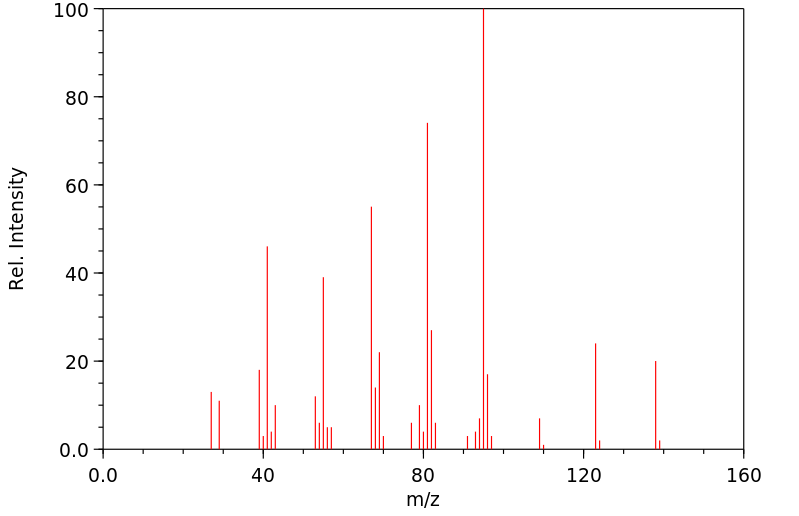3,7,7-三甲基降蒈烷 | 554-59-6
中文名称
3,7,7-三甲基降蒈烷
中文别名
3,7,7-三甲基双环[4.1.0]庚烷;蒈烷
英文名称
carane
英文别名
Caran;3,7,7-trimethylbicyclo[4.1.0]heptane
CAS
554-59-6
化学式
C10H18
mdl
——
分子量
138.253
InChiKey
BWRHOYDPVJPXMF-UHFFFAOYSA-N
BEILSTEIN
——
EINECS
——
-
物化性质
-
计算性质
-
ADMET
-
安全信息
-
SDS
-
制备方法与用途
-
上下游信息
-
文献信息
-
表征谱图
-
同类化合物
-
相关功能分类
-
相关结构分类
物化性质
-
沸点:165-166 °C(Press: 750 Torr)
-
密度:0.8381 g/cm3
-
物理描述:Solid
-
保留指数:973
-
稳定性/保质期:
存在于主流烟气中。
计算性质
-
辛醇/水分配系数(LogP):3.9
-
重原子数:10
-
可旋转键数:0
-
环数:2.0
-
sp3杂化的碳原子比例:1.0
-
拓扑面积:0
-
氢给体数:0
-
氢受体数:0
SDS
反应信息
-
作为反应物:描述:参考文献:名称:Lewina, 1934, # 3, p. 187摘要:DOI:
-
作为产物:描述:参考文献:名称:Dupont; Daure; Allard, Bulletin de la Societe Chimique de France, 1931, vol. <4> 49, p. 1401,1404摘要:DOI:
文献信息
-
Ambient Hydrogenation and Deuteration of Alkenes Using a Nanostructured Ni‐Core–Shell Catalyst作者:Jie Gao、Rui Ma、Lu Feng、Yuefeng Liu、Ralf Jackstell、Rajenahally V. Jagadeesh、Matthias BellerDOI:10.1002/anie.202105492日期:2021.8.16selective hydrogenation and deuteration of a variety of alkenes is presented. Key to success for these reactions is the use of a specific nickel-graphitic shell-based core–shell-structured catalyst, which is conveniently prepared by impregnation and subsequent calcination of nickel nitrate on carbon at 450 °C under argon. Applying this nanostructured catalyst, both terminal and internal alkenes, which
-
Air-Stable α-Diimine Nickel Precatalysts for the Hydrogenation of Hindered, Unactivated Alkenes作者:Nadia G. Léonard、Paul J. ChirikDOI:10.1021/acscatal.7b03909日期:2018.1.5isotopologues of the alkanes, signaling chain running processes that are competitive with productive hydrogenation. Stoichiometric studies, titration, and deuterium labeling experiments identified that the borane reagent served the dual role of reducing nickel(II) bis(carboxylate) to the previously reported nickel hydride dimer [(iPrDI)NiH]2 and increasing the observed hydrogenation activity. Performing the空气稳定的双(辛酸镍(II)镍(II),Ni(O 2 CC 7 H 15)2和α-二亚胺配体,iPr DI或Cy ADI(iPr DI = [2,6- i Pr 2 -C 6 H ^ 3 N = C(CH 3)] 2,赛扬ADI = [C 6 H ^ 11 N = C(CH 3)] 2)与频哪醇硼烷(HBPin)生成用于氢化受阻,基本未官能化的烯烃的高活性催化剂。氢化了一系列的三和四取代的烯烃,并证明了以数克为单位的1-苯基-1-环己烯氢化的台式操作程序,代表了这种挑战性类别的镍催化氢化反应的催化剂活性和范围的进步。烯烃。用iPr DI用原位生成的镍催化剂对1,2-二甲基茚进行氘化可独家提供1,2- syn - d 2-二甲基茚满。使用环状三取代烯烃(例如1-甲基茚和甲基环己烯),在D 2的4 atm下用原位生成的镍催化剂进行氘化产生了烷烃的多个氘代同位素,这标志着与生产性氢化竞争的链运行
-
A new approach for bio-jet fuel generation from palm oil and limonene in the absence of hydrogen作者:Jingjing Zhang、Chen ZhaoDOI:10.1039/c5cc06601h日期:——
A new solution using a carbon-chain filling strategy is proposed to convert C10 terpene and lipids to jet fuel ranged hydrocarbons with aromatic hydrocarbon ingredients in the absence of hydrogen.
-
Guha; Sankaran, Chemische Berichte, 1938, vol. 71, p. 2673作者:Guha、SankaranDOI:——日期:——
-
Heterogeneous hydrogenation of 3,7,7-trimethylcyclohepta-1,3,5-triene作者:É. N. Manukov、V. A. ChuikoDOI:10.1007/bf00575696日期:1983.7
表征谱图
-
氢谱1HNMR
-
质谱MS
-
碳谱13CNMR
-
红外IR
-
拉曼Raman
-
峰位数据
-
峰位匹配
-
表征信息
同类化合物
(5β,6α,8α,10α,13α)-6-羟基-15-氧代黄-9(11),16-二烯-18-油酸
(3S,3aR,8aR)-3,8a-二羟基-5-异丙基-3,8-二甲基-2,3,3a,4,5,8a-六氢-1H-天青-6-酮
(2Z)-2-(羟甲基)丁-2-烯酸乙酯
(2S,4aR,6aR,7R,9S,10aS,10bR)-甲基9-(苯甲酰氧基)-2-(呋喃-3-基)-十二烷基-6a,10b-二甲基-4,10-dioxo-1H-苯并[f]异亚甲基-7-羧酸盐
(1aR,4E,7aS,8R,10aS,10bS)-8-[((二甲基氨基)甲基]-2,3,6,7,7a,8,10a,10b-八氢-1a,5-二甲基-氧杂壬酸[9,10]环癸[1,2-b]呋喃-9(1aH)-酮
(+)顺式,反式-脱落酸-d6
龙舌兰皂苷乙酯
龙脑香醇酮
龙脑烯醛
龙脑7-O-[Β-D-呋喃芹菜糖基-(1→6)]-Β-D-吡喃葡萄糖苷
龙牙楤木皂甙VII
龙吉甙元
齿孔醇
齐墩果醛
齐墩果酸苄酯
齐墩果酸甲酯
齐墩果酸溴乙酯
齐墩果酸二甲胺基乙酯
齐墩果酸乙酯
齐墩果酸3-O-alpha-L-吡喃鼠李糖基(1-3)-beta-D-吡喃木糖基(1-3)-alpha-L-吡喃鼠李糖基(1-2)-alpha-L-阿拉伯糖吡喃糖苷
齐墩果酸 beta-D-葡萄糖酯
齐墩果酸 beta-D-吡喃葡萄糖基酯
齐墩果酸 3-乙酸酯
齐墩果酸 3-O-beta-D-葡吡喃糖基 (1→2)-alpha-L-吡喃阿拉伯糖苷
齐墩果酸
齐墩果-12-烯-3b,6b-二醇
齐墩果-12-烯-3,24-二醇
齐墩果-12-烯-3,21,23-三醇,(3b,4b,21a)-(9CI)
齐墩果-12-烯-3,21,23-三醇,(3b,4b,21a)-(9CI)
齐墩果-12-烯-3,11-二酮
齐墩果-12-烯-2α,3β,28-三醇
齐墩果-12-烯-29-酸,3,22-二羟基-11-羰基-,g-内酯,(3b,20b,22b)-
齐墩果-12-烯-28-酸,3-[(6-脱氧-4-O-b-D-吡喃木糖基-a-L-吡喃鼠李糖基)氧代]-,(3b)-(9CI)
齐墩果-12-烯-28-酸,3,7-二羰基-(9CI)
齐墩果-12-烯-28-酸,3,21,29-三羟基-,g-内酯,(3b,20b,21b)-(9CI)
鼠特灵
鼠尾草酸醌
鼠尾草酸
鼠尾草酚酮
鼠尾草苦内脂
黑蚁素
黑蔓醇酯B
黑蔓醇酯A
黑蔓酮酯D
黑海常春藤皂苷A1
黑檀醇
黑果茜草萜 B
黑五味子酸
黏黴酮
黏帚霉酸







